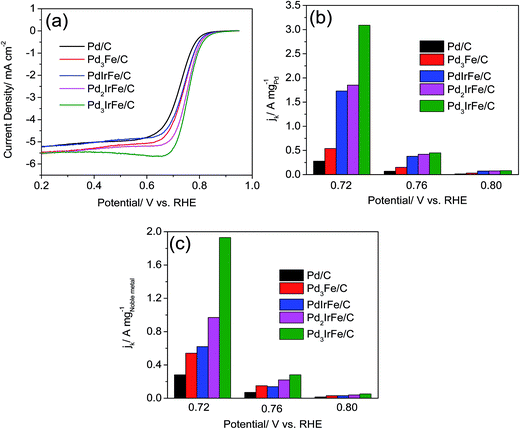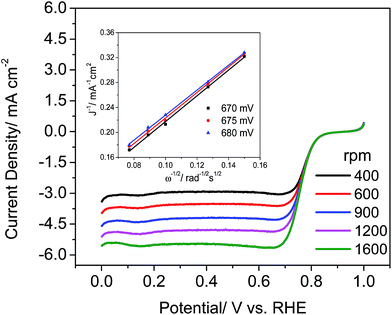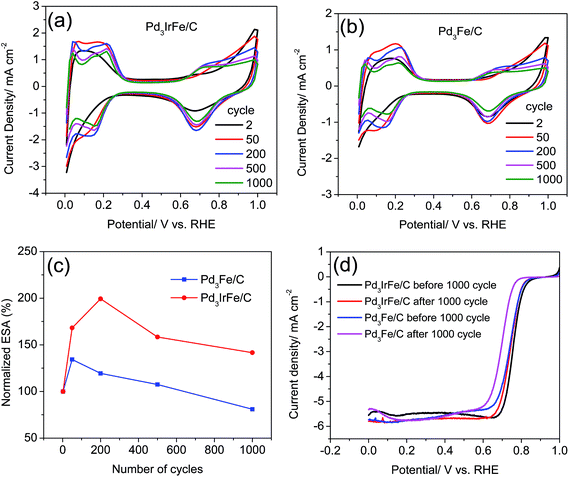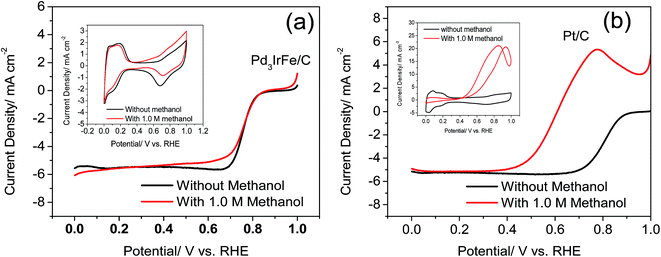Composition optimization of ternary palladium–iridium–iron alloy catalysts for oxygen reduction reaction in acid medium
Esubalew Mekuab,
Chunyu Du*ab,
Yongrong Sunb,
Lei Du b,
Yajing Wangb,
Fanpeng Kongb and
Geping Yinab
b,
Yajing Wangb,
Fanpeng Kongb and
Geping Yinab
aKey Laboratory of Materials for New Energy Conversion and Storage, Ministry of Industry and Information Technology, Harbin Institute of Technology, Harbin 150001, China. E-mail: cydu@hit.edu.cn; Fax: +86-451-86418616; Tel: +86-451-86403961
bSchool of Chemical Engineering and Technology, Harbin Institute of Technology, Harbin 150001, China
First published on 23rd February 2016
Abstract
A series of ternary PdxIrFe/C alloy catalysts with Pd![[thin space (1/6-em)]](https://www.rsc.org/images/entities/char_2009.gif) :
:![[thin space (1/6-em)]](https://www.rsc.org/images/entities/char_2009.gif) Ir
Ir![[thin space (1/6-em)]](https://www.rsc.org/images/entities/char_2009.gif) :
:![[thin space (1/6-em)]](https://www.rsc.org/images/entities/char_2009.gif) Fe atomic ratios of 1
Fe atomic ratios of 1![[thin space (1/6-em)]](https://www.rsc.org/images/entities/char_2009.gif) :
:![[thin space (1/6-em)]](https://www.rsc.org/images/entities/char_2009.gif) 1
1![[thin space (1/6-em)]](https://www.rsc.org/images/entities/char_2009.gif) :
:![[thin space (1/6-em)]](https://www.rsc.org/images/entities/char_2009.gif) 1 (denoted as PdIrFe/C), 2
1 (denoted as PdIrFe/C), 2![[thin space (1/6-em)]](https://www.rsc.org/images/entities/char_2009.gif) :
:![[thin space (1/6-em)]](https://www.rsc.org/images/entities/char_2009.gif) 1
1![[thin space (1/6-em)]](https://www.rsc.org/images/entities/char_2009.gif) :
:![[thin space (1/6-em)]](https://www.rsc.org/images/entities/char_2009.gif) 1 (denoted as Pd2IrFe/C) and 3
1 (denoted as Pd2IrFe/C) and 3![[thin space (1/6-em)]](https://www.rsc.org/images/entities/char_2009.gif) :
:![[thin space (1/6-em)]](https://www.rsc.org/images/entities/char_2009.gif) 1
1![[thin space (1/6-em)]](https://www.rsc.org/images/entities/char_2009.gif) :
:![[thin space (1/6-em)]](https://www.rsc.org/images/entities/char_2009.gif) 1 (denoted as Pd3IrFe/C) have been prepared through a microwave polyol reduction method for oxygen reduction reaction in acid medium. The morphology, structure, composition and electrochemical properties of the catalysts are analyzed by X-ray diffraction spectroscopy (XRD), transmission electron microscopy (TEM) equipped with electron diffraction spectroscopy (EDS), X-ray photoelectron spectroscopy (XPS), cyclic voltammetry (CV) and rotating disc electrode (RDE) measurements. It is clearly shown that PdxIrFe alloy nanoparticles are uniformly distributed on carbon support and Pd is enriched in the surface region of the Pd3IrFe/C catalyst. Among the PdxIrFe/C catalysts, the ternary Pd3IrFe/C alloy catalyst exhibits a rather high Pd mass activity that is 11-fold and 5.7-fold higher than that of Pd/C and Pd3Fe/C catalysts, respectively, at 0.72 V. This activity enhancement is believed to result from the surface segregation of Pd and the modification of electronic structure induced by subsurface Ir, which weakens the binding strength of oxygen-containing intermediates and further enhances their removal from the catalyst surface. Furthermore, the ternary Pd3IrFe/C alloy catalyst possesses higher methanol tolerance than the Pt/C catalyst. The ternary Pd3IrFe/C alloy electrocatalyst is a promising ORR catalytic material, especially for DMFCs.
1 (denoted as Pd3IrFe/C) have been prepared through a microwave polyol reduction method for oxygen reduction reaction in acid medium. The morphology, structure, composition and electrochemical properties of the catalysts are analyzed by X-ray diffraction spectroscopy (XRD), transmission electron microscopy (TEM) equipped with electron diffraction spectroscopy (EDS), X-ray photoelectron spectroscopy (XPS), cyclic voltammetry (CV) and rotating disc electrode (RDE) measurements. It is clearly shown that PdxIrFe alloy nanoparticles are uniformly distributed on carbon support and Pd is enriched in the surface region of the Pd3IrFe/C catalyst. Among the PdxIrFe/C catalysts, the ternary Pd3IrFe/C alloy catalyst exhibits a rather high Pd mass activity that is 11-fold and 5.7-fold higher than that of Pd/C and Pd3Fe/C catalysts, respectively, at 0.72 V. This activity enhancement is believed to result from the surface segregation of Pd and the modification of electronic structure induced by subsurface Ir, which weakens the binding strength of oxygen-containing intermediates and further enhances their removal from the catalyst surface. Furthermore, the ternary Pd3IrFe/C alloy catalyst possesses higher methanol tolerance than the Pt/C catalyst. The ternary Pd3IrFe/C alloy electrocatalyst is a promising ORR catalytic material, especially for DMFCs.
1. Introduction
Low-temperature fuel cells, particularly the polymer electrolyte membrane fuel cells (PEMFCs), are gaining considerable attention for power generation as they offer high efficiency with minimal environmental impact.1 However, the high cost of platinum used to catalyze the slow oxygen reduction reaction (ORR) at the cathode poses a serious challenge for their widespread commercialization.2,3 Considerable progress has been achieved on reducing the cost of fuel cells by alloying Pt with non-precious transition metals (such as Fe, Co, Ni, Cu),4–10 and developing core–shell or Pt monolayer structured catalysts.11–20 Despite the significant improvement in ORR activity, the inclusion of platinum as a catalyst constituent still increases the total cost of fuel cells. Furthermore, the high affinity of Pt towards the fuels crossed over from the anode, especially the methanol in direct methanol fuel cells (DMFCs), significantly reduces their activity towards ORR.21 Therefore, the development of Pt-free catalysts with high electrochemical activity and selectivity towards ORR is urgently required. Previous investigations of non-Pt cathode catalysts were based on the development of chalcogenides, porphyrins, and carbides.22 Although these catalysts exhibit higher ORR selectivity in the presence of methanol, their intrinsic activity and stability are significantly lower than those of Pt.Palladium alloys are one of the most promising alternative cathode catalysts because the ORR on the Pd alloys follows a direct 4 electron pathway and Pd has the advantages of high global availability and low cost in comparison with Pt.23 Moreover, Pd alloys possess higher methanol tolerance than Pt, which enables DMFCs to overcome the problem of methanol crossover.24–26 Binary and ternary Pd-based alloys including Pd3Co, Pd3Fe, Pd4Ni, PdCu, PdFeCo and PdCoAg have been investigated over the years as the Pt alternative cathode catalysts, which show enhanced activity and selectivity towards the ORR.27–35 Nevertheless, the ORR activity of present Pd alloys cannot meet the requirement of practical usage. Furthermore, the non-precious alloying metals are prone to dissolve into the acid electrolyte under the PEMFC operating conditions, which leads to catalyst aggregation and membrane degradation and shortens the life span of fuel cells.31,36,37 It is, therefore, a great technological importance to further improve the electrochemical activity and stability of Pd based alloy catalysts. This technological challenge can be addressed by adding additional alloying elements to the present Pd alloys. Among the available alloy elements, iridium (Ir) shows excellent stability in acid medium due to its high oxidation/reduction potential, which is above the typical operating voltage of fuel cells.38,39 Moreover, Ir plays an important role in modifying the surface electronic structure of Pd alloys, which is critical to further enhancing their catalytic activity towards the ORR. For instance, You et al. investigated Ir decorated PdCu alloy and the resulted ternary Ir–PdCu/C catalyst showed the enhanced ORR activity.40 Ham et al. also demonstrated improved ORR activity and durability of Pd–Ir–Co alloy catalyst compared with the bimetallic Pd3Co alloy.36 These previous investigations have clearly illustrated that the chemical composition is one of the important parameters to tuning the electrocatalytic properties of Pd alloy catalysts.5,26
In this study, we present a new class of carbon supported ternary PdxIrFe alloy electrocatalysts with different atomic ratios of 1![[thin space (1/6-em)]](https://www.rsc.org/images/entities/char_2009.gif) :
:![[thin space (1/6-em)]](https://www.rsc.org/images/entities/char_2009.gif) 1
1![[thin space (1/6-em)]](https://www.rsc.org/images/entities/char_2009.gif) :
:![[thin space (1/6-em)]](https://www.rsc.org/images/entities/char_2009.gif) 1, 2
1, 2![[thin space (1/6-em)]](https://www.rsc.org/images/entities/char_2009.gif) :
:![[thin space (1/6-em)]](https://www.rsc.org/images/entities/char_2009.gif) 1
1![[thin space (1/6-em)]](https://www.rsc.org/images/entities/char_2009.gif) :
:![[thin space (1/6-em)]](https://www.rsc.org/images/entities/char_2009.gif) 1 and 3
1 and 3![[thin space (1/6-em)]](https://www.rsc.org/images/entities/char_2009.gif) :
:![[thin space (1/6-em)]](https://www.rsc.org/images/entities/char_2009.gif) 1
1![[thin space (1/6-em)]](https://www.rsc.org/images/entities/char_2009.gif) :
:![[thin space (1/6-em)]](https://www.rsc.org/images/entities/char_2009.gif) 1 (denoted as PdIrFe/C, Pd2IrFe/C and Pd3IrFe/C, respectively), which are prepared by a microwave polyol reduction method. The structural characteristics and electrochemical properties of the ternary alloy PdxIrFe/C electrocatalysts have been evaluated by employing X-ray diffraction (XRD), transmission electron microscopy (TEM), X-ray photoelectron spectroscopy (XPS), cyclic voltammetry (CV) and rotating disc electrode (RDE) techniques. It is revealed that the electrocatalytic activity of the PdxIrFe/C alloy catalysts are strongly influenced by their chemical composition and the ternary Pd3IrFe/C alloy electrocatalyst exhibits the highest ORR mass activity and improved stability. Moreover, the Pd3IrFe/C alloy electrocatalyst shows higher methanol tolerance than the conventional Pt/C catalyst. As a result, the ternary PdxIrFe alloys are one kind of promising cathode catalyst, especially for direct type fuel cells.
1 (denoted as PdIrFe/C, Pd2IrFe/C and Pd3IrFe/C, respectively), which are prepared by a microwave polyol reduction method. The structural characteristics and electrochemical properties of the ternary alloy PdxIrFe/C electrocatalysts have been evaluated by employing X-ray diffraction (XRD), transmission electron microscopy (TEM), X-ray photoelectron spectroscopy (XPS), cyclic voltammetry (CV) and rotating disc electrode (RDE) techniques. It is revealed that the electrocatalytic activity of the PdxIrFe/C alloy catalysts are strongly influenced by their chemical composition and the ternary Pd3IrFe/C alloy electrocatalyst exhibits the highest ORR mass activity and improved stability. Moreover, the Pd3IrFe/C alloy electrocatalyst shows higher methanol tolerance than the conventional Pt/C catalyst. As a result, the ternary PdxIrFe alloys are one kind of promising cathode catalyst, especially for direct type fuel cells.
2. Experimental
2.1. Preparation of ternary PdxIrFe/C alloy electrocatalysts
A microwave-assistant polyol reduction method was employed to prepare the carbon supported ternary PdxIrFe alloy (PdxIrFe/C) electrocatalysts with different Pd![[thin space (1/6-em)]](https://www.rsc.org/images/entities/char_2009.gif) :
:![[thin space (1/6-em)]](https://www.rsc.org/images/entities/char_2009.gif) Ir
Ir![[thin space (1/6-em)]](https://www.rsc.org/images/entities/char_2009.gif) :
:![[thin space (1/6-em)]](https://www.rsc.org/images/entities/char_2009.gif) Fe atomic ratios (1
Fe atomic ratios (1![[thin space (1/6-em)]](https://www.rsc.org/images/entities/char_2009.gif) :
:![[thin space (1/6-em)]](https://www.rsc.org/images/entities/char_2009.gif) 1
1![[thin space (1/6-em)]](https://www.rsc.org/images/entities/char_2009.gif) :
:![[thin space (1/6-em)]](https://www.rsc.org/images/entities/char_2009.gif) 1, 2
1, 2![[thin space (1/6-em)]](https://www.rsc.org/images/entities/char_2009.gif) :
:![[thin space (1/6-em)]](https://www.rsc.org/images/entities/char_2009.gif) 1
1![[thin space (1/6-em)]](https://www.rsc.org/images/entities/char_2009.gif) :
:![[thin space (1/6-em)]](https://www.rsc.org/images/entities/char_2009.gif) 1 and 3
1 and 3![[thin space (1/6-em)]](https://www.rsc.org/images/entities/char_2009.gif) :
:![[thin space (1/6-em)]](https://www.rsc.org/images/entities/char_2009.gif) 1
1![[thin space (1/6-em)]](https://www.rsc.org/images/entities/char_2009.gif) :
:![[thin space (1/6-em)]](https://www.rsc.org/images/entities/char_2009.gif) 1) and 20 wt% of total metal loading. In the typical synthesis, the given amounts of metal precursor (FeCl2·6H2O, H2IrCl6·6H2O and H2PdCl4) solutions were added drop by drop into a suspension of Vulcan XC-72R carbon in ethylene glycol (EG) under magnetic stirring and Ar gas. After ultrasonic blending for 30 min, pH of the resulting suspension was adjusted to 10.0 using 0.5 M NaOH in EG solution. The suspension was stirred for 2 h, purged with Ar gas for 20 min to remove the dissolved oxygen, and then heated in a microwave oven for 75 s. Finally, the black product was collected by centrifugation after overnight stirring, washing with ultrapure water (18.2 MΩ) for several times and drying at 60 °C in a vacuum oven for 12 h. For comparison, carbon supported Pd, Pt and Pd3Fe catalysts with 20 wt% metal loading were also prepared following the same procedure.
1) and 20 wt% of total metal loading. In the typical synthesis, the given amounts of metal precursor (FeCl2·6H2O, H2IrCl6·6H2O and H2PdCl4) solutions were added drop by drop into a suspension of Vulcan XC-72R carbon in ethylene glycol (EG) under magnetic stirring and Ar gas. After ultrasonic blending for 30 min, pH of the resulting suspension was adjusted to 10.0 using 0.5 M NaOH in EG solution. The suspension was stirred for 2 h, purged with Ar gas for 20 min to remove the dissolved oxygen, and then heated in a microwave oven for 75 s. Finally, the black product was collected by centrifugation after overnight stirring, washing with ultrapure water (18.2 MΩ) for several times and drying at 60 °C in a vacuum oven for 12 h. For comparison, carbon supported Pd, Pt and Pd3Fe catalysts with 20 wt% metal loading were also prepared following the same procedure.
2.2. Physical characterization
The powder X-ray diffraction (XRD) patterns of the as-prepared catalysts were recorded using Panalytical Empyrean XRD system with Cu Kα (λ = 1.5406 Å) X-ray source, from which the prominent (111) peak was selected to estimate the crystallite sizes based on the Scherrer's equation. The morphology and structure of the catalysts were determined by the transmission electron microscopy (TEM) using JEM 1200EX instrument operating at 100 kV, and high resolution TEM (HRTEM) using FEI TECHNAI G2 F-30 instrument equipped with EDS at an accelerating voltage of 300 kV. The average particle size was calculated from randomly selected 150 particles in corresponding TEM images using Nano measurer 1.2.5 software. The surface composition and electronic states of the catalysts were characterized by X-ray photoelectron spectroscopy (XPS) using Thermo 250XI instrument with monochromatic Al Kα radiation (λν = 1486.6 eV).2.3. Electrochemical testing
The electrochemical experiments were performed using a three-electrode cell and a CHI604d electrochemical workstation at room temperature. A mixture of catalyst powder, isopropyl alcohol, ultrapure water and Nafion (5 wt%, DuPont) was sonicated for 30 min to prepare the homogenous catalyst ink. 20 μL of the ink was then deposited onto a glassy carbon (GC) electrode and allowed to dry in air at room temperature to form a thin catalyst layer as the working electrode with a total metal loading of 20.4 μg cm−2. The Pt foil and Hg/Hg2SO4/SO42− (sat.) electrodes were used as the counter and reference electrodes, respectively. Before the electrochemical tests, the working electrode was pretreated by cyclic voltammetry in N2 saturated 0.1 M HClO4 solution between 0.00 V and +1.00 V at a scan rate of 50 mV s−1 for 50 cycles. The ORR polarization was performed on a rotating disc electrode (RDE) in O2 saturated 0.1 M HClO4 solution at a rotation speed of 1600 rpm and a sweep rate of 5 mV s−1. The stability test of the Pd3IrFe/C and Pd3Fe/C catalysts was performed in N2 saturated 0.1 M HClO4 solution at scan rate of 50 mV s−1 for 1000 cycles at room temperature. The electrochemical surface area (ESA) was then determined by integrating the charge corresponding to reduction of surface Pd oxide for various numbers of cycles.25 The methanol tolerance of the Pd3IrFe/C and Pt/C catalysts was evaluated by using CV and RDE techniques in 1.0 M methanol and 0.1 M HClO4 solution. All the potentials were reported with respect to the reversible hydrogen electrode (RHE).3. Results and discussion
3.1. Physical characterization
The crystalline structure and crystallite size of the as-prepared samples are determined by XRD. Fig. 1a presents XRD patterns of the PdxIrFe/C catalysts with different Pd![[thin space (1/6-em)]](https://www.rsc.org/images/entities/char_2009.gif) :
:![[thin space (1/6-em)]](https://www.rsc.org/images/entities/char_2009.gif) Ir
Ir![[thin space (1/6-em)]](https://www.rsc.org/images/entities/char_2009.gif) :
:![[thin space (1/6-em)]](https://www.rsc.org/images/entities/char_2009.gif) Fe atomic ratios in comparison with Pd/C and Pd3Fe/C catalysts. The diffraction peak at around 2θ = 25° is attributed to the (002) plane of hexagonal Vulcan XC-72R carbon support. All the other peaks are assigned to the (111), (200), (220) and (311) planes of the face centered cubic (fcc) structured Pd (JCPDS no. 05-0681). It is clearly observed in these patterns that all the reflections correspond to a single fcc phase without any impurities, suggesting the formation of ternary Pd–Ir–Fe alloys.34 The diffraction peaks of ternary PdxIrFe/C alloy catalysts are shifted to higher 2θ values as clearly revealed by the enlarged (111) peaks in Fig. 1b, relative to those of Pd/C and Pd3Fe/C catalysts, suggesting the lattice contraction due to the incorporation of smaller Ir (1.35 Å) and Fe (1.27 Å) atoms into the Pd (1.37 Å) structure.29,36 Furthermore, higher shift in 2θ values is observed when the Ir content in ternary PdxIrFe/C alloys increases,37,41 indicating higher lattice contraction. This contraction is further evidenced by the smaller lattice parameters of ternary PdxIrFe/C alloys than those of Pd/C and Pd3Fe/C catalysts (Table 1). The crystallite sizes of the catalysts are calculated from the most intense (111) planes using the Debye–Scherrer formula.42 As shown in Table 1, the ternary PdxIrFe/C alloy catalysts exhibit smaller crystallite size than Pd/C and Pd3Fe/C catalysts, which should be due to the lattice contraction after the incorporation of smaller Ir into the lattice, and the decrease in surface energy after alloying, which leads to less aggregation of the alloy nanoparticles.13,36
Fe atomic ratios in comparison with Pd/C and Pd3Fe/C catalysts. The diffraction peak at around 2θ = 25° is attributed to the (002) plane of hexagonal Vulcan XC-72R carbon support. All the other peaks are assigned to the (111), (200), (220) and (311) planes of the face centered cubic (fcc) structured Pd (JCPDS no. 05-0681). It is clearly observed in these patterns that all the reflections correspond to a single fcc phase without any impurities, suggesting the formation of ternary Pd–Ir–Fe alloys.34 The diffraction peaks of ternary PdxIrFe/C alloy catalysts are shifted to higher 2θ values as clearly revealed by the enlarged (111) peaks in Fig. 1b, relative to those of Pd/C and Pd3Fe/C catalysts, suggesting the lattice contraction due to the incorporation of smaller Ir (1.35 Å) and Fe (1.27 Å) atoms into the Pd (1.37 Å) structure.29,36 Furthermore, higher shift in 2θ values is observed when the Ir content in ternary PdxIrFe/C alloys increases,37,41 indicating higher lattice contraction. This contraction is further evidenced by the smaller lattice parameters of ternary PdxIrFe/C alloys than those of Pd/C and Pd3Fe/C catalysts (Table 1). The crystallite sizes of the catalysts are calculated from the most intense (111) planes using the Debye–Scherrer formula.42 As shown in Table 1, the ternary PdxIrFe/C alloy catalysts exhibit smaller crystallite size than Pd/C and Pd3Fe/C catalysts, which should be due to the lattice contraction after the incorporation of smaller Ir into the lattice, and the decrease in surface energy after alloying, which leads to less aggregation of the alloy nanoparticles.13,36
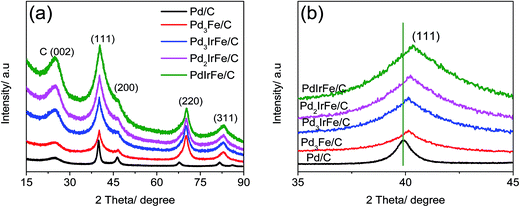 | ||
| Fig. 1 (a) XRD patterns and (b) enlarged (111) peaks of Pd/C, Pd3Fe/C and ternary PdxIrFe/C alloys with different atomic ratios. | ||
| Sample | Pd loading (μg cm−2) | Crystallite size/nm | Lattice parameter/nm | E1/2 (mV) | Mass activity @0.72 V A−1 mg−1 | |
|---|---|---|---|---|---|---|
| (Pd metal) | (noble metal) | |||||
| Pd/C | 20.4 | 8.4 | 0.3892 | 722 | 0.28 | 0.28 |
| Pd3Fe/C | 17.4 | 5.2 | 0.3879 | 737 | 0.54 | 0.54 |
| PdIrFe/C | 6.1 | 3.1 | 0.3846 | 738 | 1.73 | 0.62 |
| Pd2IrFe/C | 9.4 | 4.2 | 0.3855 | 752 | 1.85 | 0.97 |
| Pd3IrFe/C | 11.5 | 4.5 | 0.3868 | 760 | 3.09 | 1.93 |
Fig. 2 displays the TEM images and corresponding particle size distribution histograms of Pd/C, Pd3Fe/C and PdxIrFe/C samples. It can be observed that the dispersion of ternary PdxIrFe/C alloy nanoparticles on the carbon support is more uniform than that of Pd/C and Pd3Fe/C nanoparticles. The average particle size is estimated by measuring randomly selected 150 nanoparticles from the corresponding TEM images and the obtained value is 7.2 ± 1.8 nm, 5.2 ± 1.4 nm, 3.6 ± 0.7 nm, 3.4 ± 0.6 nm and 2.6 ± 0.6 nm for Pd/C, Pd3Fe/C, Pd3IrFe/C, Pd2IrFe/C and PdIrFe/C, respectively. Apparently, the ternary PdxIrFe/C alloys exhibit smaller particle size. Moreover, from the insets, the particle size distribution of ternary PdxIrFe/C alloy nanoparticles is significantly narrower than that of Pd/C and Pd3Fe/C catalysts. These results clearly reflect the improved dispersion of PdxIrFe/C alloy nanoparticles on carbon support due to the addition of relatively stable Ir,36,39 which is in accordance with the XRD results. This improved dispersion can be explained by the interaction between Pd and Ir in the PdxIrFe/C alloys, which results in the formation of a large number of Ir–Pd bonds, causing the decrease in surface energy of PdxIrFe/C alloy nanoparticles and prevents their aggregation.13 The HRTEM images of Pd/C, Pd3Fe/C and Pd3IrFe/C catalysts are shown in Fig. 3. The lattice plane spacing for Pd/C, Pd3Fe/C and Pd3IrFe/C catalysts is estimated to be 0.227 nm, 0.224 nm and 0.223 nm, respectively, which correspond to the (111) plane of Pd. The smaller lattice spacing of Pd3IrFe/C alloy demonstrates the lattice contraction, which should be induced by the incorporation of smaller Ir and Fe atoms.
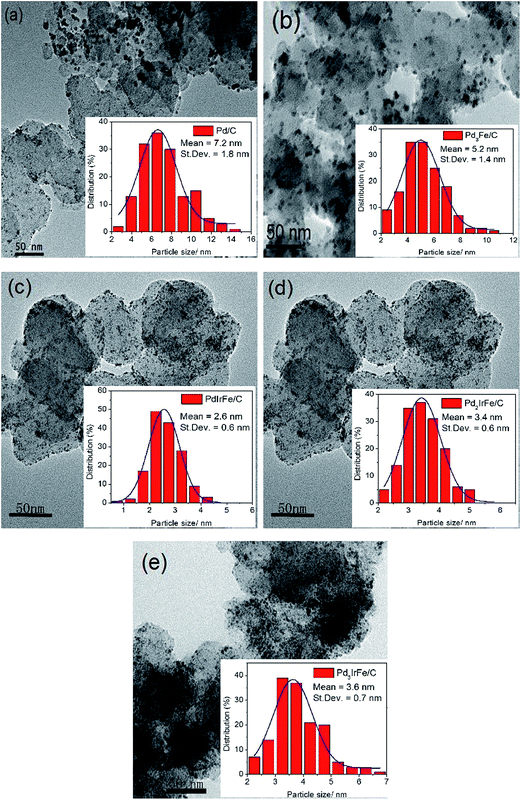 | ||
| Fig. 2 TEM images of (a) Pd/C, (b) Pd3Fe/C, (c) PdIrFe/C, (d) Pd2IrFe/C and (e) Pd3IrFe/C catalysts. Insets: the corresponding particle size distribution histograms. | ||
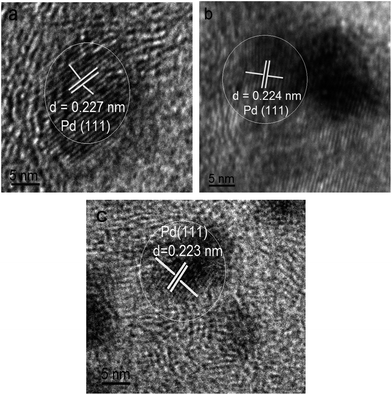 | ||
| Fig. 3 The HRTEM images of (a) Pd/C, (b) Pd3Fe/C and (c) ternary Pd3IrFe/C alloy catalysts with their corresponding measured interatom distances labeled in each image. | ||
The bulk and surface compositions of as-prepared samples are characterized by EDS and XPS analyses as presented in Table 2. The bulk composition obtained from EDS measurement is close to the nominal values, indicating the formation of alloys with the designed stoichiometry. The surface composition and electronic properties of Pd/C, Pd3Fe/C and Pd3IrFe/C catalysts are investigated from the deconvoluted core level XPS spectra as shown in Fig. 4. The Pd 3d core level XPS spectra exhibit the doublet peaks (Fig. 4a–c), which are mainly attributed to the metallic Pd 3d5/2 and Pd 3d3/2 peaks, indicating that most of Pd exists in the metallic state.43 It is interesting to note that the Pd 3d5/2 and Pd 3d3/2 peaks of Pd3IrFe/C and Pd3Fe/C catalysts shift positively in comparison with Pd/C catalyst, indicative of the compressive lattice strain due to incorporation of smaller Ir and Fe atoms into Pd structure, which is consistent with the XRD result.14,44 This lattice strain down shifts the d-band center of Pd in order to maintain the same filling degree of d-band and stabilize the d-electrons, which decreases the density of states (DOS) at the Fermi level.29 The decreased DOS leads to the difficulty in ionizing the Pd metal, so that Pd 3d binding energies increase. The shift of d-band center lowers the oxygen binding energies of intermediates and enhances their removal from the surface of Pd catalyst, leading to the enhanced catalytic activity.15 In addition, the modification of electronic structure of Pd due to the interaction between Pd, Ir and Fe also contributes to positive shift of binding energies.36,45 Fig. 4d gives the Fe 2p core level XPS spectra of Pd3IrFe/C and Pd3Fe/C catalysts. The peaks located at 706.76 eV and 706.87 eV are assigned to metallic Fe, while those at about 720.13 eV and 720.32 eV correspond to the oxidized Fe, which should be due to the exposure of the samples to air.46 It is noteworthy that the intensity of Fe 2p peaks in the ternary Pd3IrFe/C alloy catalyst is significantly lower than that in the Pd3Fe/C catalyst, illustrating the considerably lower content of Fe on the surface of ternary Pd3IrFe/C alloy catalyst (Table 2). Moreover, the surface Pd content of Pd3IrFe/C catalyst is significantly higher than the bulk value (Table 2). These results clearly demonstrate the enrichment of Pd on the surface of Pd3IrFe/C catalyst. The difference in surface Pd segregation for Pd3Fe/C and Pd3IrFe/C alloys could be attributed to the surface segregation energy of the alloying elements and the anti-segregation effect of Ir.39 Ir has higher surface segregation energy than Pd, which drives Ir to submerge beneath Pd during the heat treatment.37 Moreover, the anti-segregation effect of Ir prevents Fe atoms to segregate on the surface. Therefore, the Pd3IrFe alloy exhibits higher surface Pd segregation than the Pd3Fe alloy.
![[thin space (1/6-em)]](https://www.rsc.org/images/entities/char_2009.gif) :
:![[thin space (1/6-em)]](https://www.rsc.org/images/entities/char_2009.gif) Ir
Ir![[thin space (1/6-em)]](https://www.rsc.org/images/entities/char_2009.gif) :
:![[thin space (1/6-em)]](https://www.rsc.org/images/entities/char_2009.gif) Fe ratio (wt%) of the as-prepared alloy catalysts
Fe ratio (wt%) of the as-prepared alloy catalysts
| Sample | Nominal | EDS | XPS |
|---|---|---|---|
| Pd3Fe/C | 85![[thin space (1/6-em)]](https://www.rsc.org/images/entities/char_2009.gif) : :![[thin space (1/6-em)]](https://www.rsc.org/images/entities/char_2009.gif) 00 00![[thin space (1/6-em)]](https://www.rsc.org/images/entities/char_2009.gif) : :![[thin space (1/6-em)]](https://www.rsc.org/images/entities/char_2009.gif) 15 15 |
81![[thin space (1/6-em)]](https://www.rsc.org/images/entities/char_2009.gif) : :![[thin space (1/6-em)]](https://www.rsc.org/images/entities/char_2009.gif) 00 00![[thin space (1/6-em)]](https://www.rsc.org/images/entities/char_2009.gif) : :![[thin space (1/6-em)]](https://www.rsc.org/images/entities/char_2009.gif) 19 19 |
83![[thin space (1/6-em)]](https://www.rsc.org/images/entities/char_2009.gif) : :![[thin space (1/6-em)]](https://www.rsc.org/images/entities/char_2009.gif) 00 00![[thin space (1/6-em)]](https://www.rsc.org/images/entities/char_2009.gif) : :![[thin space (1/6-em)]](https://www.rsc.org/images/entities/char_2009.gif) 17 17 |
| PdIrFe/C | 30![[thin space (1/6-em)]](https://www.rsc.org/images/entities/char_2009.gif) : :![[thin space (1/6-em)]](https://www.rsc.org/images/entities/char_2009.gif) 54 54![[thin space (1/6-em)]](https://www.rsc.org/images/entities/char_2009.gif) : :![[thin space (1/6-em)]](https://www.rsc.org/images/entities/char_2009.gif) 16 16 |
35![[thin space (1/6-em)]](https://www.rsc.org/images/entities/char_2009.gif) : :![[thin space (1/6-em)]](https://www.rsc.org/images/entities/char_2009.gif) 51 51![[thin space (1/6-em)]](https://www.rsc.org/images/entities/char_2009.gif) : :![[thin space (1/6-em)]](https://www.rsc.org/images/entities/char_2009.gif) 14 14 |
41![[thin space (1/6-em)]](https://www.rsc.org/images/entities/char_2009.gif) : :![[thin space (1/6-em)]](https://www.rsc.org/images/entities/char_2009.gif) 55 55![[thin space (1/6-em)]](https://www.rsc.org/images/entities/char_2009.gif) : :![[thin space (1/6-em)]](https://www.rsc.org/images/entities/char_2009.gif) 04 04 |
| Pd2IrFe/C | 46![[thin space (1/6-em)]](https://www.rsc.org/images/entities/char_2009.gif) : :![[thin space (1/6-em)]](https://www.rsc.org/images/entities/char_2009.gif) 42 42![[thin space (1/6-em)]](https://www.rsc.org/images/entities/char_2009.gif) : :![[thin space (1/6-em)]](https://www.rsc.org/images/entities/char_2009.gif) 12 12 |
49![[thin space (1/6-em)]](https://www.rsc.org/images/entities/char_2009.gif) : :![[thin space (1/6-em)]](https://www.rsc.org/images/entities/char_2009.gif) 43 43![[thin space (1/6-em)]](https://www.rsc.org/images/entities/char_2009.gif) : :![[thin space (1/6-em)]](https://www.rsc.org/images/entities/char_2009.gif) 08 08 |
57![[thin space (1/6-em)]](https://www.rsc.org/images/entities/char_2009.gif) : :![[thin space (1/6-em)]](https://www.rsc.org/images/entities/char_2009.gif) 38 38![[thin space (1/6-em)]](https://www.rsc.org/images/entities/char_2009.gif) : :![[thin space (1/6-em)]](https://www.rsc.org/images/entities/char_2009.gif) 05 05 |
| Pd3IrFe/C | 56![[thin space (1/6-em)]](https://www.rsc.org/images/entities/char_2009.gif) : :![[thin space (1/6-em)]](https://www.rsc.org/images/entities/char_2009.gif) 34 34![[thin space (1/6-em)]](https://www.rsc.org/images/entities/char_2009.gif) : :![[thin space (1/6-em)]](https://www.rsc.org/images/entities/char_2009.gif) 10 10 |
59![[thin space (1/6-em)]](https://www.rsc.org/images/entities/char_2009.gif) : :![[thin space (1/6-em)]](https://www.rsc.org/images/entities/char_2009.gif) 32 32![[thin space (1/6-em)]](https://www.rsc.org/images/entities/char_2009.gif) : :![[thin space (1/6-em)]](https://www.rsc.org/images/entities/char_2009.gif) 09 09 |
72![[thin space (1/6-em)]](https://www.rsc.org/images/entities/char_2009.gif) : :![[thin space (1/6-em)]](https://www.rsc.org/images/entities/char_2009.gif) 22 22![[thin space (1/6-em)]](https://www.rsc.org/images/entities/char_2009.gif) : :![[thin space (1/6-em)]](https://www.rsc.org/images/entities/char_2009.gif) 06 06 |
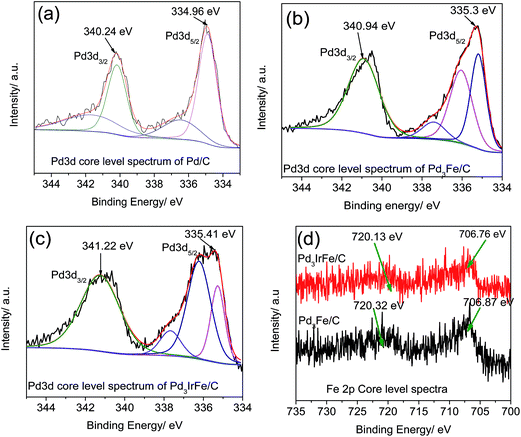 | ||
| Fig. 4 Core-level Pd 3d XPS spectra of (a) Pd/C, (b) Pd3Fe/C and (c) Pd3IrFe/C catalysts, and (d) core-level Fe 2p XPS spectra of Pd3Fe/C and Pd3IrFe/C alloy catalysts. | ||
3.2. Electrochemical performance
Electrochemical properties of the as-prepared catalysts are studied using CV and RDE techniques. Fig. 5 compares the cyclic voltammograms of the Pd/C, Pd3Fe/C and ternary PdxIrFe/C alloy electrocatalysts in N2 saturated 0.1 M HClO4 solution at a scan rate of 50 mV s−1. All the catalysts display the typical potential regions of Pd metal, including the H adsorption/desorption region (0.0–0.34 V), the double layer region (0.34–0.56 V) and the oxide formation/reduction region (above 0.56 V). The H adsorption/desorption profiles of Pd3IrFe/C, Pd2IrFe/C and PdIrFe/C alloy catalysts are remarkably different from those of Pd3Fe/C and Pd/C catalysts, indicating their significantly varied catalyst surface, which should be attributed to the alloying of Ir. Besides, it is interesting to observe that the ternary PdxIrFe/C alloy catalysts exhibit a significant increase in the H adsorption/desorption peaks relative to pure Pd/C and Pd3Fe/C catalysts, which could be due to the smaller particle size and better dispersion of PdxIrFe/C alloy catalysts.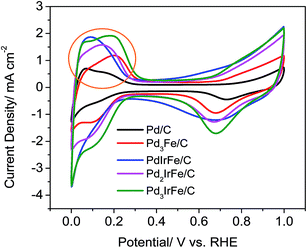 | ||
| Fig. 5 CV curves of the as-prepared catalysts in N2 saturated 0.1 M HClO4 solution at the scan rate of 50 mV s−1. | ||
The ORR activities of ternary PdxIrFe/C alloy catalysts are evaluated using the RDE technique in O2 saturated 0.1 M HClO4 solution at scan rate of 5 mV s−1 and speed of 1600 rpm. Fig. 6a displays the ORR polarization curves of the Pd/C, Pd3Fe/C and ternary PdxIrFe/C alloy catalysts. The current density is obtained by normalizing the measured current to the geometric surface area of working electrode (0.196 cm−2). From the polarization curves, the ternary PdxIrFe/C alloy catalysts exhibit higher onset potential than Pd/C and Pd3Fe/C catalysts. Moreover, for the half wave potential (E1/2) estimated from polarization curves (Table 1), the ternary Pd3IrFe/C alloy presents a 38 mV and 23 mV positive shift than Pd/C and Pd3Fe/C catalysts, respectively. These results clearly demonstrate the enhanced catalytic activity of Pd3IrFe/C catalyst towards the ORR. Fig. 6b and c give the kinetic current densities of the as-prepared catalysts normalized to the loading of Pd and noble metals, respectively. The ternary PdxIrFe/C alloy catalysts show higher mass activity than Pd/C and Pd3Fe/C catalysts. Specifically, the Pd3IrFe/C catalyst exhibits 11-fold and 5.7-fold higher Pd mass activity than Pd/C and Pd3Fe/C catalysts at 0.72 V, respectively. The enhanced activity of PdxIrFe/C catalysts could be partially ascribed to the improved dispersion of alloy catalyst nanoparticles on the carbon support. Simultaneously, the modification of surface electronic effect and geometric lattice strain due to the presence of Ir in the alloys also contribute to the activity enhancement. The ligand effect and lattice strain of Pd induced by subsurface Ir weaken the interaction between oxygen containing species and surface Pd, which facilitates their removal from the surface and therefore enhances the ORR activity.39,47,48 However, if too much Ir is alloyed with Pd and Fe, higher concentration of Ir will be present on the surface of PdxIrFe/C alloy catalysts, which induces a stronger interaction with the oxygen containing intermediates during ORR. Furthermore, Ir is more easily oxidized in comparison with Pd when contacting with oxygen.37 Both the two reasons slow the ORR kinetics.40,49 Therefore, the Pd3IrFe/C catalyst exhibits the highest mass activity among the three PdxIrFe/C catalysts.
Fig. 7 presents the ORR polarization curves of ternary Pd3IrFe/C alloy catalyst at various rotation rates in O2 saturated 0.1 M HClO4 solution. From the polarization curves, the Koutecky–Levich plots, the inverse of current density (j−1) as a function of the inverse of square roots of the rotation rates (ω−1/2) are obtained (insets of Fig. 6). The slope of the Koutecky–Levich plots can be used to determine the number of electrons transferred per oxygen molecule by employing the Koutecky–Levich equation:25,49
 | (1) |
| B = 0.62nFADO22/3υ−1/6CO2 | (2) |
![[thin space (1/6-em)]](https://www.rsc.org/images/entities/char_2009.gif) 485 C mol−1), and A the electrode surface area (0.196 cm−2). From the slope of Koutecky–Levich plots, the experimental B value of ternary Pd3IrFe/C alloy catalyst is calculated as 9.06 × 10−2 mA s1/2, which is very close to the theoretical value of 9.15 × 10−2 mA s1/2 for a four electron transfer process.48 This suggests that the ORR on the Pd3IrFe/C catalyst mainly follows a four electron pathway.
485 C mol−1), and A the electrode surface area (0.196 cm−2). From the slope of Koutecky–Levich plots, the experimental B value of ternary Pd3IrFe/C alloy catalyst is calculated as 9.06 × 10−2 mA s1/2, which is very close to the theoretical value of 9.15 × 10−2 mA s1/2 for a four electron transfer process.48 This suggests that the ORR on the Pd3IrFe/C catalyst mainly follows a four electron pathway.
The stability of Pd3IrFe/C and Pd3Fe/C catalysts is evaluated by potential cycling between 0.0 V and 1.0 V vs. RHE in N2 saturated 0.1 M HClO4 solution at a scan rate of 50 mV s−1. Fig. 8a and b show the corresponding cyclic voltammograms after 2, 50, 200, 500 and 1000 cycles. Fig. 8c demonstrates the decay in the electrochemical surface area (ESA) of Pd3IrFe/C and Pd3Fe/C catalysts after the given number of potential cycles, which could be ascribed to the high surface energy and zero-dimensional structural features of the nanocatalysts.50 It can be clearly observed that both Pd3IrFe/C and Pd3Fe/C catalysts exhibit an increased ESA in the initial cycles, suggesting the removal of contaminants from the surfaces, roughening of the surfaces and rearrangement of surface atoms.51 The ESA of Pd3Fe/C catalyst reaches a maximum value after 50 cycles and decreases promptly on further potential cycling. After 1000 cycles, the ESA of Pd3Fe/C catalyst decay by about 40% of its maximum value. In contrast, the ternary Pd3IrFe/C catalyst shows a maximum ESA after 200 cycles and then decreases slowly than Pd3Fe/C catalyst. From 500 to 1000 cycles, the ESA of Pd3IrFe/C catalyst decreases by only 14%, while that of Pd3Fe/C catalyst degrades by 24.7%. This illustrates that the stability of Pd3IrFe/C catalyst is significantly higher than that of Pd3Fe/C catalyst, which might be due to surface segregation of Pd and presence of Ir in the subsurface region that could prevent dissolution of less stable Fe into the acid electrolyte.31,36 Fig. 8d depicts the ORR polarization curves of Pd3Fe/C and Pd3IrFe/C catalysts in O2 saturated 0.1 M HClO4 solution before and after 1000 cycles. The Pd3Fe/C catalyst shows a degradation of 43 mV in half wave potential after 1000 cycles while the Pd3IrFe/C catalyst is decreased by only 17 mV. Meanwhile, the kinetic mass activity of Pd3IrFe/C catalyst exhibits a decrease of about 44 mA mg−1 at 0.80 V after 1000 cycles, which is essentially less than that of Pd3Fe/C catalyst (55.7 mA mg−1) (Table 3). This result clearly confirms the better durability of ternary Pd3IrFe/C catalyst. Similar observation has been reported for Pd–Ir–Co alloys by Ham et al.36 According to their combined DFT and experimental study, the presence of Ir in the subsurface region suppresses the diffusion of Co onto the surface and prevents its dissolution into the electrolyte solution. This explanation is also applicable to our ternary Pd3IrFe/C alloy. The presence of Ir in the subsurface region can suppress the dissolution of Fe into the acid electrolyte solution during potential cycling, resulting in high stability of ternary Pd3IrFe/C alloy catalyst.
| Catalyst | Initial | After 1000 cycles | jk loss (%) | ||||
|---|---|---|---|---|---|---|---|
| E1/2/mV | ESA/m2 g−1 Pd | jk @0.80 V (mA mg−1 Pd) | E1/2/mV | ESA/m2 g−1 Pd | jk @0.80 V (mA mg−1 Pd) | ||
| Pd3Fe/C | 737 | 39.5 | 30.5 | 694 | 23.8 | 13.5 | 55.7 |
| Pd3IrFe/C | 760 | 90.5 | 81.4 | 743 | 76.2 | 45.3 | 44.3 |
The ORR activity of ternary Pd3IrFe/C catalyst is also evaluated by the RDE technique in oxygen saturated 0.1 M HClO4 solution in the presence of methanol. Fig. 9a and b display the ORR polarization curves of Pd3IrFe/C and Pt/C catalysts in O2 saturated 0.1 M HClO4 solution with and without 1.0 M methanol at a scan rate of 5 mV s−1 and speed of 1600 rpm. It is interesting to observe that the catalytic activity of Pd3IrFe/C catalyst is remarkably higher than that of Pt/C catalyst in the presence of 1.0 M methanol. The half wave potential (E1/2) of Pt/C catalyst shifts negatively by 255 mV while that of Pd3IrFe/C shows shifts only 3 mV in the presence of 1.0 M methanol. This might be attributed to the blocking of active sites of Pt/C catalyst by organic species due to its high activity towards methanol.26 This is further illustrated by the large anodic peak observed in the ORR polarization curve of Pt/C catalyst in the presence of methanol. In contrast, no significant anodic current is observed on the ternary Pd3IrFe/C alloy, suggesting its better selectivity towards the ORR.52 From the CV curves in nitrogen saturated 0.1 M HClO4 solution (insets of Fig. 9a and b), the presence of methanol has negligible influence on ternary Pd3IrFe/C alloy catalyst. However, methanol significantly suppressed the hydrogen adsorption/desorption peaks and induces a strong methanol oxidation peak on Pt/C catalyst. These CV and RDE results reveal that the ternary Pd3IrFe/C alloy electrocatalyst is highly active towards ORR and has more methanol tolerance than the conventional Pt/C catalyst. Pt alternatives, such as carbon supported binary Pd–Fe,26 Pd–Ni31 and ternary Pd–Co–M (M = Pt, Au, Ag)34 alloys, as methanol tolerant oxygen reduction catalysts have been also investigated. However, their ORR activity and stability are lower in comparison with our Pd3IrFe/C alloy catalyst. Therefore, the ternary Pd3IrFe/C alloy electrocatalyst is a promising cathode material for DMFCs.
4. Conclusion
The effect of composition on the ORR activity of ternary PdxIrFe alloy catalysts has been explored by preparing a series of carbon supported ternary PdxIrFe alloys with atomic ratios of 1![[thin space (1/6-em)]](https://www.rsc.org/images/entities/char_2009.gif) :
:![[thin space (1/6-em)]](https://www.rsc.org/images/entities/char_2009.gif) 1
1![[thin space (1/6-em)]](https://www.rsc.org/images/entities/char_2009.gif) :
:![[thin space (1/6-em)]](https://www.rsc.org/images/entities/char_2009.gif) 1, 2
1, 2![[thin space (1/6-em)]](https://www.rsc.org/images/entities/char_2009.gif) :
:![[thin space (1/6-em)]](https://www.rsc.org/images/entities/char_2009.gif) 1
1![[thin space (1/6-em)]](https://www.rsc.org/images/entities/char_2009.gif) :
:![[thin space (1/6-em)]](https://www.rsc.org/images/entities/char_2009.gif) 1 and 3
1 and 3![[thin space (1/6-em)]](https://www.rsc.org/images/entities/char_2009.gif) :
:![[thin space (1/6-em)]](https://www.rsc.org/images/entities/char_2009.gif) 1
1![[thin space (1/6-em)]](https://www.rsc.org/images/entities/char_2009.gif) :
:![[thin space (1/6-em)]](https://www.rsc.org/images/entities/char_2009.gif) 1 with microwave polyol reduction method. The ternary PdxIrFe/C alloys form well-defined single phase fcc structure with narrower particle size distribution. Moreover, segregation of Pd is observed on the surface of ternary Pd3IrFe/C alloy catalyst. Among the PdxIrFe alloys, the Pd3IrFe/C alloy catalyst shows the best ORR mass activity, which can be ascribed to the surface segregation of Pd and the modification of electronic structure induced by subsurface Ir. In addition, the Pd3IrFe/C alloy catalyst has more methanol tolerance. The ternary PdxIrFe/C alloy catalysts are promising non-platinum cathode materials for DMFCs.
1 with microwave polyol reduction method. The ternary PdxIrFe/C alloys form well-defined single phase fcc structure with narrower particle size distribution. Moreover, segregation of Pd is observed on the surface of ternary Pd3IrFe/C alloy catalyst. Among the PdxIrFe alloys, the Pd3IrFe/C alloy catalyst shows the best ORR mass activity, which can be ascribed to the surface segregation of Pd and the modification of electronic structure induced by subsurface Ir. In addition, the Pd3IrFe/C alloy catalyst has more methanol tolerance. The ternary PdxIrFe/C alloy catalysts are promising non-platinum cathode materials for DMFCs.
Acknowledgements
This work was supported by the National Science Foundation of China under contract no. 21376057 and 21433003.References
- X. Z. Yuan and H. Wang, Hand book of PEM fuel cell Electrocatalysts and catalyst layers: Fundamentals and Applications, Springer, London, 2008 Search PubMed
.
- S. Litster and G. McLean, J. Power Sources, 2004, 130, 61 CrossRef CAS
.
- C. Song and J. Zhang, Hand book of PEM fuel cell Electrocatalysts and catalyst layers: Fundamentals and Applications, Springer, London, 2008 Search PubMed
.
- H. Liu, D. Xia and J. Zhang, Hand book of PEM fuel cell Electrocatalysts and catalyst layers: Fundamentals and Applications, Springer, London, 2008 Search PubMed
.
- W. Chen, J. Kim, S. Sun and S. Chen, J. Phys. Chem. C, 2008, 112, 3891 CAS
.
- M. Oezaslan, F. Hasché and P. Strasser, J. Electrochem. Soc., 2012, 159, B394 CrossRef CAS
.
- E. I. Santiago, L. C. Varanda and H. M. Villullas, J. Phys. Chem. C, 2007, 111, 3146 CAS
.
- C. Cui, L. Gan, H.-H. Li, S.-H. Yu, M. Heggen and P. Strasser, Nano Lett., 2012, 12, 5885 CrossRef CAS PubMed
.
- M. Oezaslan, F. Hasché and P. Strasser, J. Electrochem. Soc., 2012, 159, B444 CrossRef CAS
.
- C. Wang, N. M. Markovic and V. R. Stamenkovic, ACS Catal., 2012, 2, 891 CrossRef CAS
.
- Y. Chen, Z. Liang, F. Yang, Y. Liu and S. Chen, J. Phys. Chem. C, 2011, 115, 24073 CAS
.
- R. Choi, S. Choi, C. H. Choi, K. M. Nam, S. Woo, J. T. Park and S. W. Han, Chem.–Eur. J., 2013, 19, 8190 CrossRef CAS PubMed
.
- T. Cochell and A. Manthiram, Langmuir, 2012, 28, 1579 CrossRef CAS PubMed
.
- J. Yang, X. Chen, X. Yang and J. Y. Ying, Energy Environ. Sci., 2012, 5, 8976 CAS
.
- J. Yang, X. Chen, F. Ye, C. Wang, Y. Zheng and J. Yang, J. Mater. Chem., 2011, 21, 9088 RSC
.
- W. Wang, R. Wang, S. Ji, H. Feng, H. Wang and Z. Lei, J. Power Sources, 2010, 195, 3498 CrossRef CAS
.
- A. U. Nilekar, Y. Xu, J. Zhang, M. B. Vukmirovic, K. Sasaki, R. R. Adzic and M. Mavrikakis, Top. Catal., 2007, 46, 276 CrossRef CAS
.
- M. B. Vukmirovic, Y. Cai, S. T. Bliznakov, K. Sasaki, J. X. Wang and R. R. Adzic, ECS Trans., 2012, 45, 15 CrossRef CAS
.
- R. R. Adzic, Electrocatalysis, Springer Science + Business Media, LLC, 2012 Search PubMed
.
- M. Shao, K. Shoemaker, A. Peles, K. Kaneko and L. Protsailo, J. Am. Chem. Soc., 2010, 132, 9253 CrossRef CAS PubMed
.
- J. Xu, J. Yang, J. Y. Lee and M. Saeys, Ind. Eng. Chem. Res., 2010, 49, 10251 CrossRef CAS
.
- Y. Feng and N. Alonso-Vante, Phys. Status Solidi B, 2008, 245, 1792 CrossRef CAS
.
- J. J. Salvador-Pascual, S. Citalán-Cigarroa and O. Solorza-Feria, J. Power Sources, 2007, 172, 229 CrossRef CAS
.
- E. Antolini, Energy Environ. Sci., 2009, 2, 915 CAS
.
- K. Mohanraju and L. Cindrella, RSC Adv., 2014, 4, 11939 RSC
.
- M. Neergat, V. Gunasekar and R. Rahul, J. Electroanal. Chem., 2011, 658, 25 CrossRef CAS
.
- L. Arroyo-Ramírez, R. Montano-Serrano, T. Luna-Pineda, F. R. Román, R. G. Raptis and C. R. Cabrera, ACS Appl. Mater. Interfaces, 2013, 5, 11603 Search PubMed
.
- K. Oishi and O. Savadogo, J. Electroanal. Chem., 2013, 703, 108 CrossRef CAS
.
- M. H. Shao, K. Sasaki and R. R. Adzic, J. Am. Chem. Soc., 2006, 128, 3526 CrossRef CAS PubMed
.
- W. Li and P. Haldar, Electrochem. Commun., 2009, 11, 1195 CrossRef CAS
.
- J. Zhao, A. Sarkar and A. Manthiram, Electrochim. Acta, 2010, 55, 1756 CrossRef CAS
.
- X. Wang, N. Kariuki, J. T. Vaughey, J. Goodpaster, R. Kumar and D. J. Myers, J. Electrochem. Soc., 2008, 155, B602 CrossRef CAS
.
- W. Tang, L. Zhang and G. Henkelman, J. Phys. Chem. Lett., 2011, 2, 1328 CrossRef CAS PubMed
.
- J. Mathiyarasu and K. L. N. Phani, J. Electrochem. Soc., 2007, 154, B1100 CrossRef CAS
.
- B. Y. Xia, Y. Yan, X. Wang and X. W. Lou, Mater. Horiz., 2014, 1, 379 RSC
.
- H. C. Ham, D. Manogaran, K. H. Lee, K. Kwon, S.-a. Jin, D. J. You, C. Pak and G. S. Hwang, J. Chem. Phys., 2013, 139, 201104 CrossRef PubMed
.
- S. L. Knupp, M. B. Vukmirovic, P. Haldar, J. A. Herron, M. Mavrikakis and R. R. Adzic, Electrocatalysis, 2010, 1, 213 CrossRef CAS
.
- S. J. Hwang, S. J. Yoo, T.-Y. Jeon, K.-S. Lee, T.-H. Lim, Y.-E. Sung and S.-K. Kim, Chem. Commun., 2010, 46, 8401 RSC
.
- Y. Ma and P. B. Balbuena, J. Electrochem. Soc., 2010, 157, B959 CrossRef CAS
.
- D. J. You, S.-a. Jin, K. H. Lee, C. Pak, K. H. Choi and H. Chang, Catal. Today, 2012, 185, 138 CrossRef CAS
.
- M. H. M. T. Assumpçao, S. G. da Silva, R. F. B. De Souza, G. S. Buzzo, E. V. Spinace, M. C. Santos, A. O. Neto and J. C. M. Silva, J. Power Sources, 2014, 268, 129 CrossRef
.
- S. Thanasilp and M. Hunsom, Renewable Energy, 2011, 36, 1795 CrossRef CAS
.
- M. Brun, A. Berthet and J. C. Bertolini, J. Electron Spectrosc. Relat. Phenom., 1999, 104, 55 CrossRef CAS
.
- J. C. Vickerman, Surface analysis – the principal techniques, John Wiley & Sons, 1997 Search PubMed
.
- J. Chen, Y. Li, Z. Gao, G. Wanga, J. Tiana, C. Jiang, S. Zhu and R. Wang, Electrochem. Commun., 2013, 37, 24 CrossRef CAS
.
- M. R. Tarasevich, G. V. Zhutaeva, V. A. Bogdanovskaya, M. V. Radina, M. R. Ehrenburg and A. E. Chalykh, Electrochim. Acta, 2007, 52, 5108 CrossRef CAS
.
- M. Shao, P. Liu, J. Zhang and R. Adzic, J. Phys. Chem. B, 2007, 111, 6772 CrossRef CAS PubMed
.
- P. Strasser, S. Koh, T. Anniyev, J. Greeley, K. More, C. Yu, Z. Liu, S. Kaya, D. Nordlund, H. Ogasawara, M. F. Toney and A. Nilsson, Nat. Chem., 2010, 2, 454 CrossRef CAS PubMed
.
- M. H. Shao, T. Huang, P. Liu, J. Zhang, K. Sasaki, M. B. Vukmirovic and R. R. Adzic, Langmuir, 2006, 22, 10409 CrossRef CAS PubMed
.
- B. Y. Xia, W. T. Ng, H. B. Wu, X. Wang and X. W. Lou, Angew. Chem., 2012, 124, 7325 CrossRef
.
- B. Y. Xia, H. B. Wu, X. Wang and X. W. Lou, J. Am. Chem. Soc., 2012, 134, 13934 CrossRef CAS PubMed
.
- D. Wang, H. L. Xin, H. Wang, Y. Yu, E. Rus, D. A. Muller, F. J. DiSalvo and H. D. Abruña, Chem. Mater., 2012, 24, 2274 CrossRef CAS
.
| This journal is © The Royal Society of Chemistry 2016 |

